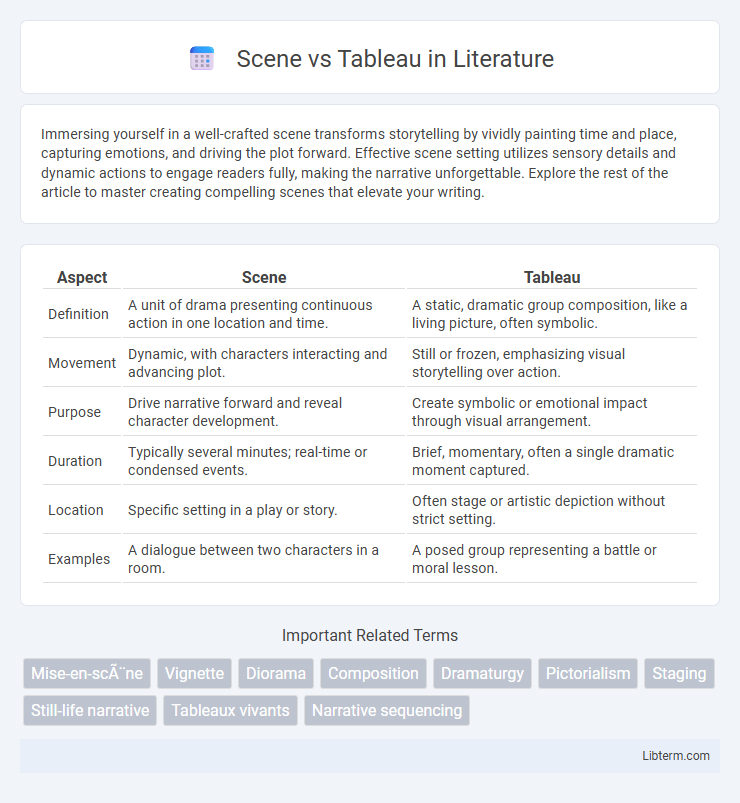Immersing yourself in a well-crafted scene transforms storytelling by vividly painting time and place, capturing emotions, and driving the plot forward. Effective scene setting utilizes sensory details and dynamic actions to engage readers fully, making the narrative unforgettable. Explore the rest of the article to master creating compelling scenes that elevate your writing.
Table of Comparison
| Aspect | Scene | Tableau |
|---|---|---|
| Definition | A unit of drama presenting continuous action in one location and time. | A static, dramatic group composition, like a living picture, often symbolic. |
| Movement | Dynamic, with characters interacting and advancing plot. | Still or frozen, emphasizing visual storytelling over action. |
| Purpose | Drive narrative forward and reveal character development. | Create symbolic or emotional impact through visual arrangement. |
| Duration | Typically several minutes; real-time or condensed events. | Brief, momentary, often a single dramatic moment captured. |
| Location | Specific setting in a play or story. | Often stage or artistic depiction without strict setting. |
| Examples | A dialogue between two characters in a room. | A posed group representing a battle or moral lesson. |
Understanding the Concepts: Definition of Scene and Tableau
A scene represents a specific moment or event within a narrative, typically composed of continuous action in a particular setting, emphasizing temporal progression and character interaction. A tableau, by contrast, is a static, visually composed arrangement of characters or elements that conveys a broader concept or theme without movement or time sequence, often capturing a symbolic or emotional snapshot. Understanding these definitions highlights their distinct narrative functions: scenes advance the story through dynamic events, while tableaux encapsulate meaning through deliberate visual composition.
Historical Origins of Scene and Tableau
The historical origins of scenes trace back to ancient Greek theater, where individual scenes depicted specific moments within a play to guide audience understanding and narrative flow. Tableaux emerged in the Renaissance period as static, visually rich arrangements of actors frozen in expressive poses, inspired by classical art and religious imagery to convey symbolic meaning without dialogue or movement. This evolution highlights the scene's focus on sequential storytelling contrasted with the tableau's emphasis on pictorial representation and dramatic emphasis.
Visual Narrative: Scene vs Tableau in Storytelling
Scene and tableau diverge in visual narrative by emphasizing dynamic action versus staged composition. A scene captures continuous movement and character interaction, driving plot progression through real-time engagement. Conversely, a tableau presents a static, carefully arranged moment rich in symbolic detail, allowing viewers to interpret underlying themes and emotions at a glance.
Key Differences Between Scene and Tableau
Scene represents a single continuous setting or location in a play or film, highlighting real-time actions and character interactions without significant shifts in time or place. Tableau, in contrast, is a static, posed arrangement of characters or objects designed to convey a symbolic or thematic moment, often used to evoke emotion or illustrate a narrative snapshot without motion or dialogue. Key differences include Scene's dynamic progression and chronological flow versus Tableau's deliberate stillness and visual symbolism, emphasizing narrative movement versus thematic representation.
Techniques for Creating Powerful Scenes
Techniques for creating powerful scenes include using vivid imagery, dynamic character interactions, and precise emotional cues to immerse the audience. In contrast, tableaux rely on carefully composed static images that emphasize symbolic gestures and spatial relationships to convey meaning. Mastering scene construction enhances narrative momentum, while effective tableaux highlight thematic depth through visual storytelling.
Crafting Impactful Tableaux: Methods and Tips
Crafting impactful tableaux involves strategically arranging characters and props to convey a clear narrative moment, emphasizing visual composition and emotional expression. Key methods include using dynamic body language, contrasting colors, and layered depth to create focal points that guide audience attention effectively. Enhancing tableaux with well-planned lighting and deliberate spatial relationships amplifies storytelling power without relying on dialogue or action.
Scene vs Tableau in Visual Arts
Scene and tableau in visual arts represent distinct methods of storytelling and composition; a scene depicts a continuous action with dynamic elements and character interactions, while a tableau captures a single, static moment often arranged like a still life with deliberate poses. Scenes emphasize narrative progression and temporal flow, engaging viewers with ongoing events, whereas tableaux focus on symbolic or thematic expression through carefully composed imagery. Artists use scenes to convey drama and movement, while tableaux serve to highlight aesthetic details and evoke contemplation.
Scene vs Tableau in Theater and Performance
In theater and performance, a scene refers to a continuous block of storytelling that takes place in a single location and time frame, driving narrative progression and character development. A tableau, by contrast, is a static, deliberate arrangement of actors resembling a living picture, often used to emphasize a dramatic moment or theme without dialogue or action. Scenes prioritize movement and plot advancement, while tableaux focus on visual composition and symbolic meaning within a theatrical production.
Advantages and Drawbacks of Scenes and Tableaux
Scenes provide dynamic, immersive storytelling by allowing real-time interaction and multiple sensory inputs, enhancing user engagement and narrative depth. However, they can demand high computational resources and complex design, which may limit accessibility and scalability. Tableaux offer static visual representations that simplify complex information and are easier to produce and replicate, but they lack interactivity and may result in less engaging user experiences.
Choosing the Right Approach: Scene or Tableau?
When deciding between Scene and Tableau, assess the project's complexity and desired level of detail to determine the best fit. Scene excels in immersive, multi-layered presentations with dynamic interactions, while Tableau offers robust data visualization capabilities for clear, concise analytics. Prioritize Scene for storytelling and spatial depth, whereas Tableau is optimal for data-driven insights and easy report sharing.
Scene Infographic

 libterm.com
libterm.com